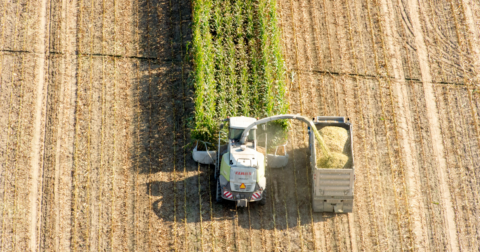News
The Trump Administration Wants to Gut The Clean Water Act
Policy•8 min read
News
While SNAP payments and food safety inspections continue, disaster payments, farm loans and federal workers’ pay are on hold indefinitely.


Words by Seth Millstein
As the U.S. government shutdown enters its second full week, lawmakers appear no closer to resolving the impasse. As a result of Congress’s inability to pass a government funding bill, an estimated 750,000 federal workers have been furloughed, and more are working without pay. Farmers and agricultural producers are among those impacted by the shutdown — but how much disruption will they face?
If the shutdown is only short-term, the impact to farms and ranches will likely be “very modest,” Vincent Smith, professor in agricultural economics at Montana State University, tells Sentient. “It’s much more difficult to know what a three-month or six-month government shutdown would do.”
Even though the U.S. Department of Agriculture has been forced to furlough nearly half its staff, many of its most essential functions will continue — unless the shutdown goes on long enough. Let’s take a look.
Around 42,256 of the nearly 86,000 staffers at the USDA have been furloughed as a result of the shutdown, and many of the agency’s normal functions and duties have been put on pause, and won’t resume until the government opens.
This includes many of the USDA’s subsidy programs for farmers. The USDA offers various forms of financial assistance to agricultural producers, including loans, disaster payments after extreme weather events, price supports and funding for conservation efforts. Much of this will cease due to the shutdown. The Farm Service Agency will not give out loan payments or process new loans.
Disaster assistance payments related to significant weather-related disasters aren’t being processed due to the shutdown, and neither are payments from the Supplemental Disaster Assistance programs authorized by the American Relief Act.
All 8,849 staff members at the USDA’s Natural Resources Conservation Service (NRCS) have been furloughed. The National Organic Program has ceased operations, and the National Agricultural Statistics Service (NASS) has stopped collecting and publishing agricultural research data.
In addition, the Trump administration has repeatedly threatened mass layoffs of federal workers if the shutdown impasse isn’t resolved quickly, though these may be illegal.
So the shutdown is clearly having an effect on both federal workers and agriculture. But a lot of significant USDA activity is continuing despite the lapse in funding.
Over 90 percent of the staff at the USDA’s Food Safety and Inspection Service remain at work, some without pay. Food safety inspections of meat and poultry processing plants are continuing during the shutdown, and so are investigations and laboratory work on disease outbreaks and public health threats, such as avian flu, swine fever, rabies and the New World screwworm.
Around 71 percent of the USDA’s spending goes toward nutritional assistance, and these programs are still operating during the shutdown — for now. Supplemental Nutrition Assistance Program (SNAP) recipients are still receiving their funds, and the program is still accepting new enrollees, though their applications may take longer to process than normal.
The USDA will continue to disperse SNAP benefits through the end of October, according to the agency’s shutdown plan, and many recipients have already received their October benefits. The Child Nutrition Program, which provides healthy meals for children at daycare centers, after-school programs and other institutions, will also be funded through the end of October.
There’s been concern that the Special Supplemental Nutrition Program for Women, Infants and Children (WIC) could run out of funding during the shutdown. However, Axios reported Tuesday that WIC will continue to be funded “for the foreseeable future” using tariff revenues.
Beyond that, though, it’s unclear. Though the agency does have some contingency funds that it could use for SNAP and the Child Nutrition Program if the shutdown stretches into November, it hasn’t confirmed how long those funds will last, and the administration hasn’t revealed how much tariff revenue will be diverted to keep WIC running.
It’s worth noting that the most recent government shutdown also took place under a Trump presidency, and SNAP recipients continued to receive their benefits throughout. At 35 days, that was the longest shutdown in U.S. history.
Programs related to preventing and combatting wildfires are continuing unabated, as is protection of federal land and infrastructure that’s necessary to “ensure health and safety of the public.” Certain conservation and disaster prevention initiatives, such as dam monitoring programs and the Emergency Watershed Protection Program, are also unaffected by the shutdown.
In addition to all of this, the USDA’s work on the newest version of the Dietary Guidelines for Americans is continuing during the shutdown. That might sound like an odd thing for the agency to prioritize, given that Health and Human Services Secretary Robert F. Kennedy, Jr. has been cagey about when the guidelines will be released and they have already been delayed once, but the government is required by law to release the new version by the end of the year.
The sheer number of USDA programs that have been halted due to the shutdown may seem alarming. And it is having some immediate impact; the lapse in funding for the National Organic Program, for instance, means that the USDA hasn’t been conducting its usual oversight of Certified Organic farms to ensure that they comply with the agency’s organic standards.
However, Smith says that the shutdown’s cumulative impact on American agriculture as a whole will be minimal. The interruption in services will largely amount to “an inconvenience,” he says, not a major financial burden or existential threat.
“[Farmers] will be delayed in filing for benefits, and filing paperwork they need to file to be eligible for disaster aid, and so on,” Smith says. “And that is, for almost all those farmers, an inconvenience.”
Take Agricultural Risk Coverage and Price Loss Coverage, two major USDA programs that have been suspended due to the shutdown. These are government-subsidized insurance plans for farmers: When either the market price of certain commodities or a farm’s actual revenue drops below a certain level, the ARC and PLC give them a payout to cover the difference. It is, in essence, taxpayer-funded profit insurance for farmers.
There’s a larger debate to be had over whether these programs should exist in the first place, as almost no other industry in the U.S. enjoys government protection against falling profits. But the merits of the programs notwithstanding, the pause in ARC and PLC payments will only have a minimal impact on farms for a number of reasons.
For one, the programs are both highly concentrated to a relatively small share of the overall farming sector. Only 27 percent of U.S. farmland is covered by the programs in the first place, and around 85.5 percent of payments go to growers of just three crops: corn, wheat and soybeans.
But more importantly, almost all farmers in the U.S. also earn money from non-farm sources, and on average, it’s the non-farm income that provides the bulk of their annual income.
“It’s a university professor who owns the family farm,” Smith says of farming households. “It’s a real estate broker who owns the family farm. It’s the local farmer who works as a postman, and whose wife is a school teacher.”
In 2023, for instance, farming households in the U.S. didn’t make very much money from farming. In fact, most farms lost money: Median farm-related income was -$900 for farm households that year. This might sound catastrophic — except for the fact that, thanks to off-farm earnings, the median total income for U.S. farmers that year was $97,894. In total, only 23 percent of farm households’ income came from actual farming in 2023. The average farm in the U.S. holds around $1.4 million in wealth.
For these reasons, the delay in Agricultural Risk Coverage and Price Loss Coverage payments “is not in any way a financial crisis” for American farmers, says Smith. Even a three-month pause to these checks would not “cause catastrophe, unless the operator of the farm is a very poor manager and has an unrealistic view of the nature of agricultural markets,” Smith says.
Though new farm loans will be halted, less than 2 percent of all farms received USDA loans in 2024. “That is an extraordinarily small number of farms,” Smith says. “It doesn’t mean that you shouldn’t be sympathetic to their plight, but it is not a situation that would justify…major subsidies for losses incurred during the shutdown.”
Because the shutdown is unlikely to significantly affect the bottom lines of agricultural producers, Smith doesn’t foresee any increase in food prices.
“In terms of the supply chain of food to the supermarket, and the price that someone on SNAP benefits would have to pay for Hamburger Helper, the impacts are going to be essentially unseeable,” Smith says.
However, other policies of the Trump administration, such as tariffs, have already caused food prices to rise since January 2025, and these effects will continue.
Though the shutdown is unlikely to have catastrophic effects on food and farming in the U.S., that’s not reason to be sanguine or complacent about it.
As mentioned earlier, SNAP benefits could be at risk if the shutdown stretches beyond October. In addition, the Trump administration’s threats of mass layoffs of federal workers appear to be still on the table.
Moreover, because most USDA research will be paused during the shutdown, Smith warns that the president could use this as a pretext for permanently cutting research funding, which would have a serious impact on the agricultural sector.
If the Trump administration uses the shutdown as an excuse to substantially cut research budgets, “the long-run impacts will be severe on agricultural productivity and nutrition-related technological developments,” Smith says. It’s worth mentioning, though, that Trump had already cut funding for, or outright eliminated, a number of USDA research programs even before the shutdown.
A government shutdown is never a good thing. They happen when Congress is unable to fulfill its most basic duty (funding the federal government), and are a symptom of deep institutional dysfunction.
But while the current shutdown will have some impact on federal agricultural policies, it’s not wreaking havoc on the U.S. farm sector — at least, not for now.